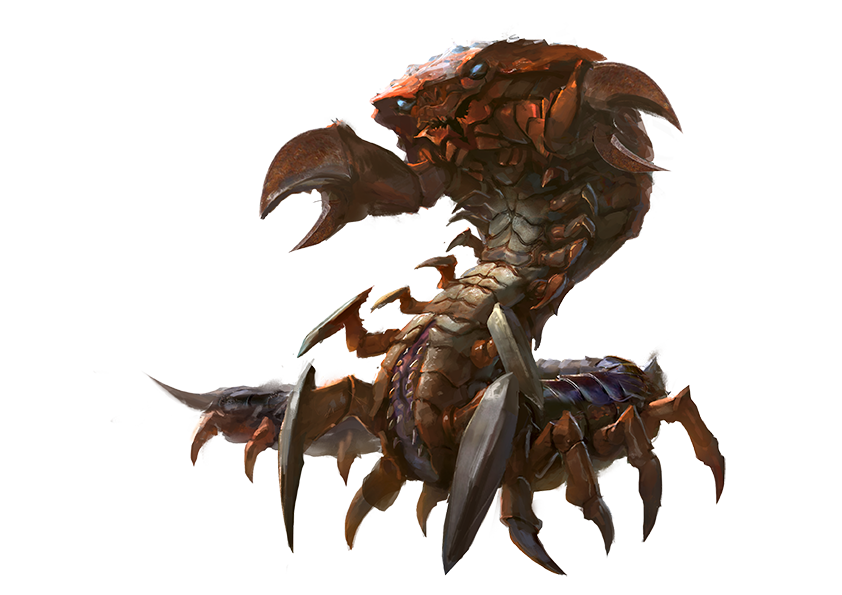KhefakSource Alien Archive 2 pg. 78
Khefaks are a sort of arthropod—similar to a cross between a centipede and crab—with a hard exoskeleton, 20 segmented legs, and frontfacing pincers. A long slit runs from the creature’s head to its midpoint that functions for eating, birthing, and excretion. A khefak uses its pincers to hack edible materials apart and its legs to sort and shovel chunks into its maw, which is full of grinding points. A khefak’s carapace varies based on diet, but every khefak craves thasteron. Any khefak that consumes thasteron rapidly swells in size, its exoskeleton gaining a crystalline appearance.
Akiton thrived during the years when starships required thasteron for space travel. During that time, a firm called Khefak Biogenetics genetically engineered the first khefaks to consume thasteron rubble, scrap, and dust and then biochemically refine what would be waste material back into usable fuel. When the thasteron market crashed after the advent of Drift travel, Akitonian mining corporations abandoned their mines and refineries along with the khefaks. The arthropods were expected to die with the thasteron market, but they didn’t.
Created to reproduce rapidly and adapt to polluted environments, khefaks had no trouble acclimating to their new conditions. Freed from the thasteron facilities, the khefaks began consuming other inorganic materials. As their numbers grew, these pests began to stow away on starfaring vessels and appear on other worlds, but governments’ preventive measures have largely restricted khefaks to Akiton.
Khefaks have a high metabolism, devouring plastics, composites, and most metals, but they don’t eat soil or similar substances. A khefak must eat many times its weight each day, so a khefak incursion can cause rapid structural damage.
On Akiton, locals hunt khefaks to control their numbers and keep them from invading functioning structures. Although the creatures’ flesh isn’t edible, khefaks nonetheless make valuable targets because the creatures incorporate minerals they eat into their carapace plates and refine some substances into a purer form. Scavengers kill the creatures for bounties and to collect enough shells to sell as mineral compounds or make useful items.
Khefaks reproduce asexually when they have ample food, producing one offspring every few days. Young provided an adequate source of nutrition grow to maturity within days. When khefaks consume every available scrap, they spread out to new areas. If a source of food can’t be located, the khefaks find a safe place to hibernate and can endure for years in this state. Few worlds that have modern societies lack refined materials khefaks can consume, so starvation among these creatures is rare—on Akiton, it’s unheard of.
The survival of the khefak species on Akiton is all but assured, since some locals raise and train the creatures. Trainers transport khefaks to abandoned areas and release them to pick through ruins. The released khefaks then locate and consume valuable salvage in locations dangerous to other life. The resulting exoskeletons can be harvested for considerable profit. This practice, along with any sort of khefak “farming,” is illegal in numerous regions on Akiton.Khefak Exoskeletons Genetic engineers designed the khefak carapace for easy harvest. Within hours of a khefak’s death, its connective tissue degenerates, making the carapace easy to hollow out with about 1 minute of work. The carapace can then be refined for various uses. Depending on the diet of a khefak, its clean exoskeleton has a market value between 5 and 50 credits. A thasteron khefak carapace is worth 30 credits.Aliens in the "Khefak" FamilySource Alien Archive 2 pg. 78Khefak CR 1/3 XP 135 XP 135
N Small vermin
Init +1; Senses blindsense (vibration) 30 ft., darkvision 60 ft.; Perception +3
DefenseHP 6
EAC 10; KAC 12
Fort +3; Ref +1; Will +0
Immunities radiation
OffenseSpeed 20 ft., burrow 5 ft., climb 20 ft.
Melee claw +4 (1d6 S)
Offensive Abilities break objectsStatisticsSTR +0; DEX +1; CON +3; INT —; WIS +0; CHA -3
Other Abilities consume objects, mindlessEcologyEnvironment any (Akiton)
Organization solitary, pair, colony (3–9), or infestation (10–40)Special AbilitiesBreak Objects (Ex) When attacking an object, a khefak treats that object’s hardness as if it were 10 lower.
Consume Objects (Ex) A khefak can eat objects with hardness 10 or lower. A khefak deals 1 damage to an object it’s consuming per minute. A khefak is sated and stops feeding on a given day after dealing 50 damage this way.
|